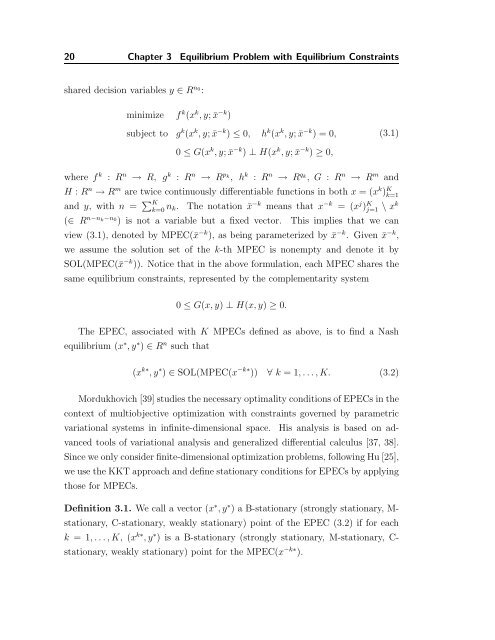equilibrium problems with equilibrium constraints - Convex ...
equilibrium problems with equilibrium constraints - Convex ...
equilibrium problems with equilibrium constraints - Convex ...
You also want an ePaper? Increase the reach of your titles
YUMPU automatically turns print PDFs into web optimized ePapers that Google loves.
20 Chapter 3 Equilibrium Problem <strong>with</strong> Equilibrium Constraints<br />
shared decision variables y ∈ R n 0<br />
:<br />
minimize f k (x k , y; ¯x −k )<br />
subject to g k (x k , y; ¯x −k ) ≤ 0, h k (x k , y; ¯x −k ) = 0,<br />
(3.1)<br />
0 ≤ G(x k , y; ¯x −k ) ⊥ H(x k , y; ¯x −k ) ≥ 0,<br />
where f k : R n → R, g k : R n → R p k , h k : R n → R q k , G : R n → R m and<br />
H : R n → R m are twice continuously differentiable functions in both x = (x k ) K k=1<br />
and y, <strong>with</strong> n = ∑ K<br />
k=0 n k. The notation ¯x −k means that x −k = (x j ) K j=1 \ xk<br />
(∈ R n−n k−n 0<br />
) is not a variable but a fixed vector. This implies that we can<br />
view (3.1), denoted by MPEC(¯x −k ), as being parameterized by ¯x −k . Given ¯x −k ,<br />
we assume the solution set of the k-th MPEC is nonempty and denote it by<br />
SOL(MPEC(¯x −k )). Notice that in the above formulation, each MPEC shares the<br />
same <strong>equilibrium</strong> <strong>constraints</strong>, represented by the complementarity system<br />
0 ≤ G(x, y) ⊥ H(x, y) ≥ 0.<br />
The EPEC, associated <strong>with</strong> K MPECs defined as above, is to find a Nash<br />
<strong>equilibrium</strong> (x ∗ , y ∗ ) ∈ R n such that<br />
(x k∗ , y ∗ ) ∈ SOL(MPEC(x −k∗ )) ∀ k = 1, . . .,K. (3.2)<br />
Mordukhovich [39] studies the necessary optimality conditions of EPECs in the<br />
context of multiobjective optimization <strong>with</strong> <strong>constraints</strong> governed by parametric<br />
variational systems in infinite-dimensional space. His analysis is based on advanced<br />
tools of variational analysis and generalized differential calculus [37, 38].<br />
Since we only consider finite-dimensional optimization <strong>problems</strong>, following Hu [25],<br />
we use the KKT approach and define stationary conditions for EPECs by applying<br />
those for MPECs.<br />
Definition 3.1. We call a vector (x ∗ , y ∗ ) a B-stationary (strongly stationary, M-<br />
stationary, C-stationary, weakly stationary) point of the EPEC (3.2) if for each<br />
k = 1, . . .,K, (x k∗ , y ∗ ) is a B-stationary (strongly stationary, M-stationary, C-<br />
stationary, weakly stationary) point for the MPEC(x −k∗ ).
















